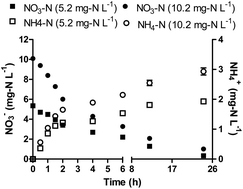Nitrate and ammonium ions removal from groundwater by a hybrid system of zero-valent iron combined with adsorbents
Abstract
Nitrate (NO3−) is a commonly found contaminant in groundwater and surface

* Corresponding authors
a
Department of Environmental Engineering, Yonsei University, Wonju, Gangwon-do, South Korea
E-mail:
bhjeon@yonsei.ac.kr
Fax: +82 33 760 2571
Tel: +82 33 760 2446
b
Economy Environment Urban Division, Jeju Development Institute, JeJu, South Korea
E-mail:
gwaterpark@jdi.re.kr
Fax: +82 64 751 2168
Tel: +82 64 726 6142
c Chemistry Department, College of Science, King Saud University, Riyadh, Saudi Arabia
d Department of Environmental Biotechnology, City of Scientific Research and Technology Applications, New Borg El Arab City, Alexandria, Egypt
e Geologic Environment Division, KIGAM, Daejeon, South Korea
f Department of Environmental Engineering, Daejeon University, Daejeon, South Korea
g KIST Gangneung Institute, Gangneung, South Korea
h Department of Environment and Energy, Sejong University, Seoul, South Korea
Nitrate (NO3−) is a commonly found contaminant in groundwater and surface

 Please wait while we load your content...
Something went wrong. Try again?
Please wait while we load your content...
Something went wrong. Try again?
M. Ji, W. Park, M. A. Khan, R. A. I. Abou-Shanab, Y. Kim, Y. Cho, J. Choi, H. Song and B. Jeon, J. Environ. Monit., 2012, 14, 1152 DOI: 10.1039/C2EM10911E
To request permission to reproduce material from this article, please go to the Copyright Clearance Center request page.
If you are an author contributing to an RSC publication, you do not need to request permission provided correct acknowledgement is given.
If you are the author of this article, you do not need to request permission to reproduce figures and diagrams provided correct acknowledgement is given. If you want to reproduce the whole article in a third-party publication (excluding your thesis/dissertation for which permission is not required) please go to the Copyright Clearance Center request page.
Read more about how to correctly acknowledge RSC content.
 Fetching data from CrossRef.
Fetching data from CrossRef.
This may take some time to load.
Loading related content
